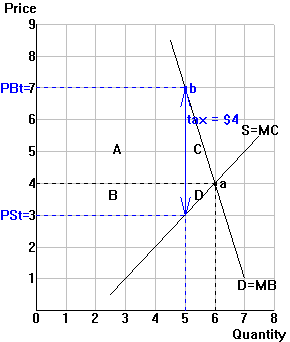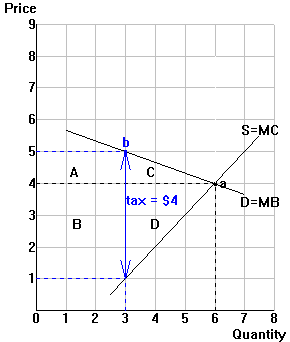Relatively inelastic demand
Relatively elastic demand


The economic effects of taxes
Consider the contrast between relatively inelastic and relatively elastic demand:
Relatively inelastic demand |
Relatively elastic demand |
 |
 |
Diagrammatic results:
| Lefthand diagram | Righthand diagram | |
| 1. the new equilibrium quantity (Qt) | 5 | |
| 2. the new price to buyers, including taxes: | 7 | |
| 3. the new price received by sellers, after taxes: | 3 | |
| 4. the change in consumer surplus (loss = AC) | -16.5 | |
| 5. the change in producer surplus (loss = BD) | -5.5 | |
| 6. the tax revenues collected by the government (AB) | +20 | |
| 7. the welfare loss (deadweight loss) to society (CD) | -2 | |
| 8. percentage of tax paid by buyers | 75% | |
| 9. percentage of tax paid by sellers | 25% |
Note 1: It is not government laws but the laws of supply and demand which
determine who ultimately pays a tax.
Note 2: Buyers tend to pay more of a tax when demand is inelastic compared to
supply, and sellers tend to pay more of a tax when demand is elastic compared to supply.
Note 3: Since it is only the size of a tax which matters and not who is
formally assessed it, you can show any tax any way you please: you can simply insert a
"wedge" equal to the size of the tax between supply and demand, or shift supply
up or shift demand down by the amount of the tax. By convention, most economists shift
supply up, but feel free to do whatever makes most sense to you.